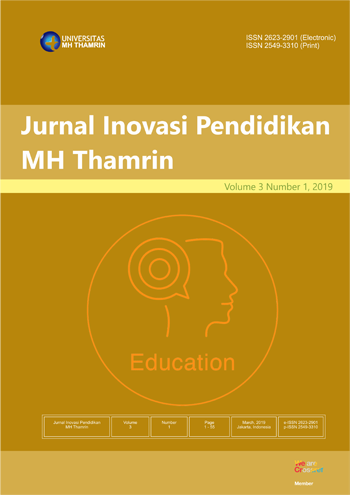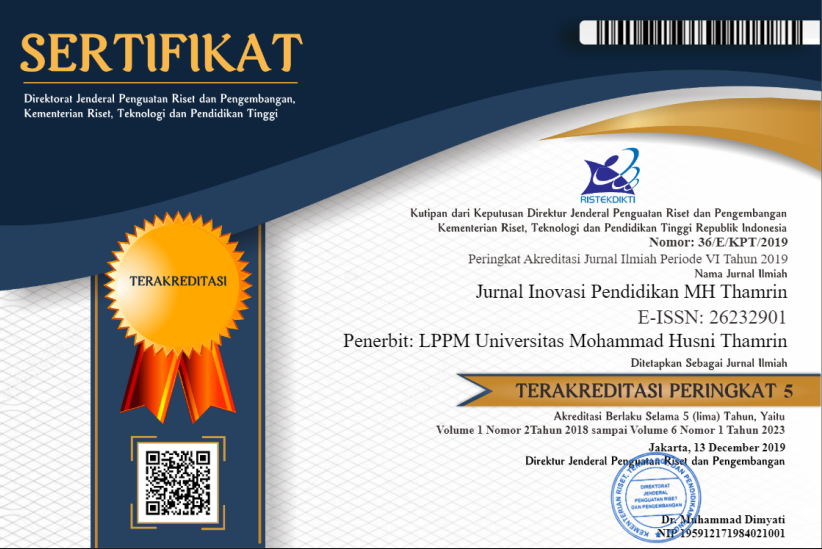Potensi Integrasi Kearifan Lokal Dayak Dalam Pembelajaran Ilmu Pengetahuan Alam Di Sekolah Dasar Kota Palangka Raya
DOI:
https://doi.org/10.37012/jipmht.v4i1.198Keywords:
worldview, sifat IPA, kearifan lokalAbstract
Fokus studi ini adalah untuk mengidentifikasi sifat pandangan dunia yang dianut oleh calon guru pendidikan dan mengeksplorasi hubungan, jika ada, antara pandangan dunia mereka dan konsepsi mereka tentang sifat sains. Selain itu, implikasi dari hubungan ini untuk pengajaran dan pembelajaran sains dibahas. Pesertanya adalah 30 calon guru IPA Dayak. Konsepsi mereka tentang ilmu pengetahuan alam dan pandangan dunia mereka yang spesifik tentang hubungan manusia dengan alam dinilai menggunakan kuesioner yang berhubungan dengan wawancara lanjutan. Hasil penelitian menunjukkan bahwa 70% dari peserta, terlepas dari latar belakang budaya mereka, memiliki pandangan dunia yang berpusat pada alam, sementara 30% dari mereka memiliki pandangan dunia antroposentris. Dan hasil wawancara menegaskan bahwa partisipan memiliki pandangan sempit tentang hakikat sains, dimana mereka mendeskripsikan sains hanya berdasarkan fakta, berpusat pada observasi, tidak kreatif dan tentatif karena perubahan fakta. Studi ini menyarankan perlunya memasukkan perspektif sosiokultural dan sifat sains dalam kurikulum.
References
Acciaioli, G. (2007). From customary law to indigenous sovereignty: Reconceptualizing masyarakat adat in contemporary Indonesia. The revival of tradition in Indonesian politics. The deployment of adat from colonialism to indigenism, 295-318.
Ahmad, S. (2014). Problematika Kurikulum 2013 dan Kepemimpinan Instruksional Kepala Sekolah. Jurnal Pencerahan, 8(2).
Aikenhead, G. S. (1996). Science education: Border crossing into the subculture of science. Studies in Science Education, 27, 1-52
Aikenhead, G. S., & Jegede, O. J. (1999). Cross-cultural ‘science’ education: A cognitive explanation of a cultural phenomenon. Journal of Research in ‘science’ Teaching, 36(3), 269– 287.https://doi.org/10.1002/(SICI)1098-2736(199903)36:3<269::AID-TEA3>3.0.CO;2-T
Akena, F. A. (2012). Critical analysis of the production of western knowledge and its implications for indigenous knowledge and decolonization. Journal of Black Studies, 43(6), 599–619. https://doi.org/10.1177/0021934712440448
Anazifa, D., & Hadi, R. F. (2017). The Integration of Javanese Indigenous Knowledge in Biology Learning Resources Development. In Journal of Physics: Conference Series (Vol. 812, No. 1,
p. 012057). IOP Publishing.
Asmar, C., & Page, S. (2009). Sources of satisfaction and stress among Indigenous academic teachers: Findings from a national Australian study. Asia Pacific Journal of Education, 29(3), 387-401.
Baier, M. (2007). The Development of the Hindu Kaharingan Religion: A New Dayak Religion in Central Kalimantan. Anthropos, (H. 2), 566-570.
Baynes, R. (2016). Teachers’ Attitudes to Including Indigenous Knowledges in the Australian ‘science’ Curriculum. The Australian Journal of Indigenous Education, 45(01), 80-90.
Ben-Zvi Assaraf, O., Eshach, H., Orion, N., & Alamour, Y. (2012). Cultural differences and students’ spontaneous models of the water cycle: A case study of Jewish and Bedouin children in Israel. Cultural Studies of ‘science’ Education, 7(2), 451–477. https://doi.org/10.1007/s11422-012-9391-5
Bohensky, E. L., & Maru, Y. (2011). Indigenous knowledge, ‘science’, and resilinece: What have we learned from a decade of International literature on “Integration� Ecology and Society, 16(4). https://doi.org/http://dx.doi.org/10.5751/ES-04342-160406
Boon, H. J. (2012). Regional Queensland parents’ views of ‘science’ education: Some unexpected perceptions. Australian Educational Researcher, 39(1), 17–43. https://doi.org/10.1007/s13384- 011-0045-5
Boulton, A. J., Panizzon, D., & Prior, J. (2005). Explicit knowledge structures as a tool for overcoming obstacles to interdisciplinary research. Conservation Biology, 19(6), 2026–2029. https://doi.org/10.1111/j.1523-1739.2005.00314.x
Bourke, B. (2014). The qualitative report positionality: Reflecting on the research process. The Qualitative Report, 19(33), 1–9.
Brown, D. A., Pipe, M. E., Lewis, C., Lamb, M. E., & Orbach, Y. (2007). Supportive or suggestive: Do human figure drawings help 5-to 7-year-old children to report touch? Journal of Consulting and Clinical Psychology, 75(1), 33.
Bruck, M. (1999). A summary of an affidavit prepared for Commonwealth of Massachusetts v.
Cheryl Amirault LeFave. Applied Developmental Science, 3(2), 110-127.
Cajkler, W., Wood, P., Norton, J., & Pedder, D. (2014). Lesson study as a vehicle for collaborative teacher learning in a secondary school. Professional development in education, 40(4), 511-529.
Chilisa, B. (2012). Indigenous research methodologies. Thousand Oaks, CA: Sage.
Chinn, P. W. (2007). Decolonizing methodologies and indigenous knowledge: The role of culture, place and personal experience in professional development. Journal of research in science teaching, 44(9), 1247-1268.
Crossan, F. (2003). Research philosophy: towards an understanding. Nurse Researcher, 11(1), 46– 55. https://doi.org/10.7748/nr2003.10.11.1.46.c5914
Davis, N. T., & Callihan, L. P. (2013). Integral methodological pluralism in ‘science’ education research: Valuing multiple perspectives. Cultural Studies of ‘science’ Education, 8(3), 505– 516. https://doi.org/10.1007/s11422-012-9480-5
Dei, G. S. (2013). Critical perspectives on indigenous research. Socialist Studies/Études Socialistes, 9(1)
Feyerabend, P. (2010). Against method 4thed. London: Verso
Fullan, M.G. (1993). Why teacher must become change agents. The Professional Teacher, 50(6), 12-17
Gadgil, M., Berkes, F., & Folke, C. (1993). Indigenous knowledge for biodiversity conservation.
Ambio, 151-156.
Gardner, R. C. & Lambert, W. E. (1959). Motivational variables in second language acquisition.
Canadian Journal of Psychology, 13, 266-272.
Gardner, R. C. & Lambert, W. E. (1965). Language, attitude, intelligence, and second language achievement. Journal of Educational Psychology, 56, 191-199.
Gardner, R. C. & Lambert, W. E. (1972). Attitudes and Motivation in Second Language Learning.
Newbury House: Rowley Mass
Getty, G. A. (2010). The journey between Western and Indigenous research paradigms. Journal of Transcultural Nursing, 21(1), 5-14.
Giroux, H. (1992). Border crossings: Cultural workers and the politics of education. New York: Routledge Press
Glasson, G. E., Frykholm, J. A., Mhango, N. A., & Phiri, A. D. (2006). Understanding the earth systems of Malawi: Ecological sustainability, culture, and placeâ€based education. Science Education, 90(4), 660-680.
Glasson, G. E., Mhango, N., Phiri, A., & Lanier, M. (2010). Sustainability science education in Africa: Negotiating indigenous ways of living with nature in the third space. International Journal of Science Education, 32(1), 125-141.
Gondwe, M., & Longnecker, N. (2014). Scientific and cultural knowledge in intercultural ‘science’ education: Student perceptions of common ground. Research in ‘science’ Education, 45(1), 117–147. https://doi.org/10.1007/s11165-014-9416-z
Hamlin, M. L. (2013). “Yo soy indÃgenaâ€: Identifying and using traditional ecological knowledge (TEK) to make the teaching of ‘science’ culturally responsive for Maya girls. Cultural Studies of ‘science’ Education, 8(4), 759–776. https://doi.org/10.1007/s11422-013-9514-7
Jenks, C. (1993). Culture. London: Routledge
Kidman, J., Yen, C.F., Abrams, E. (2013). Indigenous Students’ experiences of the hidden curriculum in ‘science’ education: a cross-national study in New Zealand and Taiwan. International Journal of ‘science’ and Mathematics Education, 11, 43–64
Kilbourn, B. (2006). The qualitative doctoral dissertation proposal. Teachers College Record, 108(4), 529
Lamb, M. E., Orbach, Y., Hershkowitz, I., Esplin, P. W., & Horowitz, D. (2007). A structured forensic interview protocol improves the quality and informativeness of investigative interviews with children: A review of research using the NICHD Investigative Interview Protocol. Child abuse & neglect, 31(11), 1201-1231.
Lavallée, L. F. (2009). Practical application of an Indigenous research framework and two qualitative Indigenous research methods: Sharing circles and Anishnaabe symbol-based reflection. International journal of qualitative methods, 8(1), 21-40.
Lee, H., Yen, C. F., & Aikenhead, G. S. (2012). Indigenous elementary students’ Science instruction in Taiwan: indigenous knowledge and western Science. Research in Science Education, 42(6), 1183-1199.
Lewis, C. (2002). Lesson study: A handbook of teacher-led instructional change. Philadelphia: Research for better schools, Inc.
Li, T. M. (2000). Articulating indigenous identity in Indonesia: Resource politics and the tribal slot. Comparative studies in society and history, 42(01), 149-179.
Lowan, G. (2012). Expanding the conversation: Further explorations into Indigenous environmental ‘science’ education theory, research, and practice. Cultural Studies of ‘science’ Education, 7(1), 71–81. https://doi.org/10.1007/s11422-012-9379-1
Mack, E., Augare, H., Cloud-Jones, L. D., DavÃd, D., Gaddie, H. Q., Honey, R. E., … Wippert, R. (2012). Effective practices for creating transformative informal ‘science’ education programsgrounded in Native ways of knowing. Cultural Studies of ‘science’ Education, 7(1), 49–70. https://doi.org/10.1007/s11422-011-9374-y
Mazzocchi, F. (2006). Western science and traditional knowledge. EMBO reports, 7(5), 463-466. Miles, M. B., & Huberman, A. M. (1994). Qualitative data analysis: An expanded sourcebook.
Sage.
Ministry of Education and Culture. (2013). Curriculum 2013. Retrieved from https://urip.files.wordpress.com/2013/02/kurikulum-2013-kompetensi-dasar-sd-ver-3-3- 2013.pdf
Moller, H., Berkes, F., Lyver, P. O. B., & Kislalioglu, M. (2004). Combining science and traditional ecological knowledge: monitoring populations for co-management. Ecology and society, 9(3).
Online at http://www.ecologyandsociety.org/vol9/iss3/art2/
Morrow, S. L. (2005). Quality and trustworthiness in qualitative research in counseling psychology.
Journal of counseling psychology, 52(2), 250.
Mpofu, V., Otulaja, F. S., & Mushayikwa, E. (2014). Towards culturally relevant classroom ‘science’: A theoretical framework focusing on traditional plant healing. Cultural Studies of ‘science’ Education, 9(1), 221–242. https://doi.org/10.1007/s11422-013-9508-5
Nakashima, D., Roue, M. (2002). Indigenous knowledge, people and sustainable practice.
Encyclopedia of Global Environmental Change, 5, 314-324
Nakata, M. (2002). Indigenous knowledge and the cultural interface: Underlying issues at the intersection of knowledge and information systems. IFLA journal, 28(5-6), 281-291.
Safitri, M.A & Bosko, R.E. (2002). Indigenous people/ethnic minorities and poverty reduction indonesia. Manila: Asian Development Bank
Saher, P.J. (1969). Eastern wisdom and western thought: a comparative study in the modern philosophy of religion. London: Allen & Unwin
Salirawati, D; Wismono, J; Riyanto. (2010). Gembira Belajar IPA 1. Jakarta: Pusat Perbukuan, Kementrian Pendidikan Nasional.
Saito, E., Harun, I., Kuboki, I., & Tachibana, H. (2006). Indonesian lesson study in practice: Case study of Indonesian mathematics and science teacher education project. Journal of In-service Education, 32(2), 171-184.
Settlage, J., & Southerland, S. A. (2007). Teaching science to every child: Using culture as a starting point. Taylor & Francis.
Sillitoe, P. (1998). The Development of indigenous knowledge. Current Anthropology, 39(2), 223– 252. https://doi.org/10.1086/204722
Suja, W, (2011). Analisis kebutuhan pengembangan buku ajar sains SD bermuatan pedagogi budaya Bali. Jurnal Pendidikan dan Pengajaran, 44 (1), 84-92
Suratno, T. (2012). Lesson Study as Practice: An Indonesian Elementary School Experience. Online Submission.
Sutherland, D., & Swayze, N. (2012). The importance of place in indigenous ‘science’ education. Cultural Studies of ‘science’ Education, 7(1), 83–92. https://doi.org/10.1007/s11422-011- 9371-1
Tacconi, L., Moore, P. F., & Kaimowitz, D. (2007). Fires in tropical forests–what is really the problem? Lessons from Indonesia. Mitigation and adaptation strategies for global change, 12(1), 55-66.
Thomas, G. (2009). How to do your research project: A guide for students in education and applied social ‘science’s. London: SAGE Publication Ltd
Thomas, G. (2011). How to do your case study. London: SAGE Publication Ltd.
Thomson, L. K. (2000). The effect of the Dayak worldview, customs, traditions, and customary law (adat-istiadat) on the interpretation of the Gospel in West Kalimantan, Indonesian Borneo. DMin thesis, Acadia University, 122.
Yin, R. K. (2014). Case study research: Design and methods. Sage publications.
Downloads
Published
How to Cite
Issue
Section
Citation Check
License
Jurnal Inovasi Pendidikan MH Thamrin allows readers to read, download, copy, distribute, print, search, or link to the full texts of its articles and allow readers to use them for any other lawful purpose. The journal allows the author(s) to hold the copyright without restrictions. Finally, the journal allows the author(s) to retain publishing rights without restrictions Authors are allowed to archive their submitted article in an open access repository Authors are allowed to archive the final published article in an open access repository with an acknowledgment of its initial publication in this journal.

Jurnal Inovasi Pendidikan MH Thamrin is licensed under a Creative Commons Attribution 4.0 International License.











